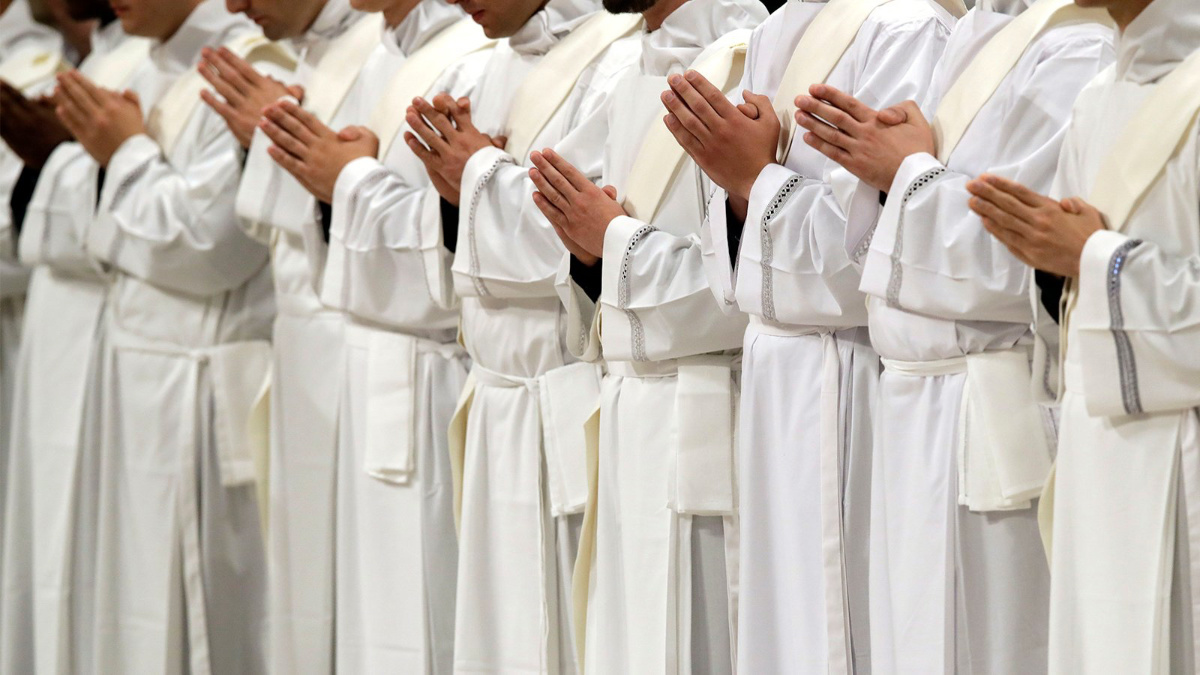
PHYLLIS ZAGANO, in an article first published on Religion News Service, says allowing women only in management and not in ministry ignores church history…
United States
RNS
The Synod on Synodality is exploding ideas all over the church. Some on the extreme right hope for Tridentine Masses. Some on the far left hope for changes in teachings on sex and gender. Folks in the middle just want more respect for and better recognition of women.
To no-one’s surprise, the working document for the synod’s “continental phase” recognised women as the backbone of the church. It also admits that many women feel denigrated, neglected and misunderstood, symptomatic of narcissistic clericalism infecting clergy. The national synod reports sent to the Vatican from bishops’ conferences around the globe uniformly presented the desire for women to be present in church governance, certified as preachers and in the diaconate.

Newly ordained priests pray during a ceremony led by Pope Francis in St Peter’s Basilica at the Vatican on 12th May, 2019. PICTURE: AP Photo/Alessandra Tarantino.
Pope Francis’ recent comments about women are not helpful. Yes, on the aircraft returning from Bahrain in early November, he decried treating women as “second-class citizens”. But in a 24th November speech before the International Theological Commission (27 men, five women) Francis took aim at dissident Old Catholic Churches that ordain women – he did not distinguish whether as priests or as deacons – while at the same time saying he would like to increase the number of women on that very commission.
“The Petrine theory is the root of the so-called argument from authority against women priests: Jesus chose male apostles, and the church is bound by his choice…That rules out women in positions of genuine authority. The surprise in the Marian theory is that older documents say the diaconate is and acts ‘in the name of the church’. So, if the church is female, then ordained deacons should mirror that fact.”
Speaking with America, the Jesuit magazine, a few days later, Francis used the theology of Swiss priest Hans Urs von Balthasar to cancel the idea of women in ministry, while approving of women in management. Von Balthasar, a close associate of Joseph Ratzinger (the retired Pope Benedict XVI) presented two principles that put women in their place: the “Petrine principle”, which defines ministry as masculine, and the “Marian principle”, which defines the church as female.
As Francis told America’s interviewers: “And why can a woman not enter ordained ministry? It is because the Petrine principle has no place for that. Yes, one has to be in the Marian principle, which is more important. Woman is more, she looks more like the church, which is mother and spouse. I believe that we have too often failed in our catechesis when explaining these things.”
Toward the end of his comments on women, he recommended a “third way”: Increase the number of women in administrative positions, in management.
So that is that. Management, but not ministry.
Except.
The Petrine theory is the root of the so-called argument from authority against women priests: Jesus chose male apostles, and the church is bound by his choice. Only priests can have governance and jurisdiction; they are ordained “in persona Christi capitas ecclesiae” – in the person of Christ the head of the church. That rules out women in positions of genuine authority.
The surprise in the Marian theory is that older documents say the diaconate is and acts “in the name of the church”. So, if the church is female, then ordained deacons should mirror that fact.
To complicate matters, the priesthood came about some two centuries after the diaconate. History records ordained women deacons up through the 12th century, with bishops ordaining women as deacons using liturgies often identical to those for male deacons. The bishops invoked the confirmation of the Holy Spirit and placed a stole around the ordained women’s necks. Most importantly, the bishops called these ordained women deacons.
We rely on our readers to fund Sight's work - become a financial supporter today!
For more information, head to our Subscriber's page.
For too long, theologians battled over whether diaconal ordination was a sacrament, but that was apparently first resolved at the 16th century Council of Trent. So, women were sacramentally ordained as deacons. It will not take a third Vatican Council to reaffirm that.
Or will it? Lately, the question of ordination for women seems restricted to the growing requests for women priests. Even Francis uses that shorthand. But the tradition of ordaining women as deacons could easily be restored. Benedict XVI even changed canon law in 2009 to emphasise the fact that the diaconate is not the priesthood.
So, which is it? As the Synod on Synodality enters its “continental phase”, the tide could be turning against women in ministry. Does the working document’s call for “a diaconate of women” mean ordained women deacons, or something else? If it means something else, why? Is it because the deacon is ordained to act and to be “in the person of Christ, the servant?” Does it indicate an official teaching that women cannot image Christ?
No doubt, the theological hair-splitting is lost on the people of God. But the church is dangerously close to losing even more members when it states – or seems to state – that women cannot image Christ – that is, that women are not made in the image and likeness of God. That is not a good stance for the Vatican. It is something papal briefers and speechwriters need to recognise, and soon.

Phyllis Zagano is senior research associate-in-residence and adjunct professor of religion at Hofstra University in Hempstead, New York. Her most recent book is Elizabeth Visits the Abbey.
This article contains an affiliate link.






